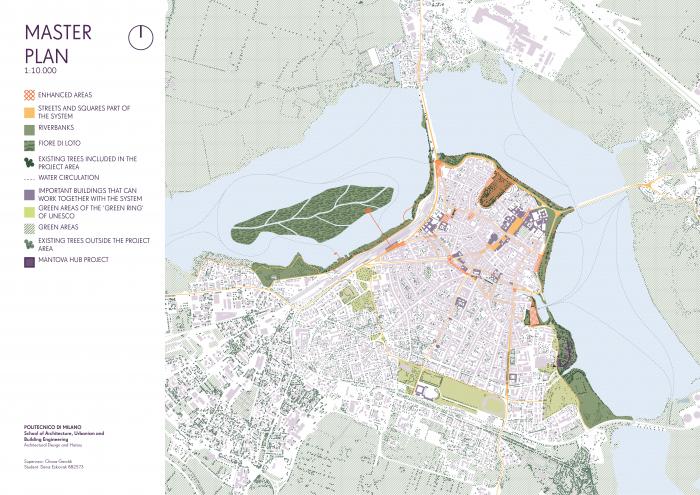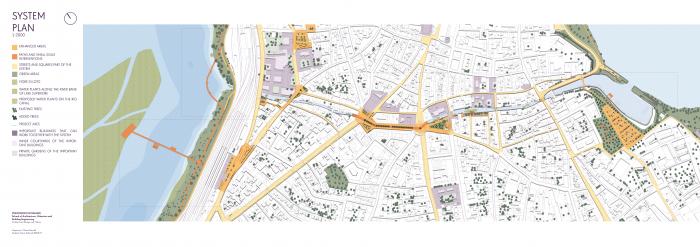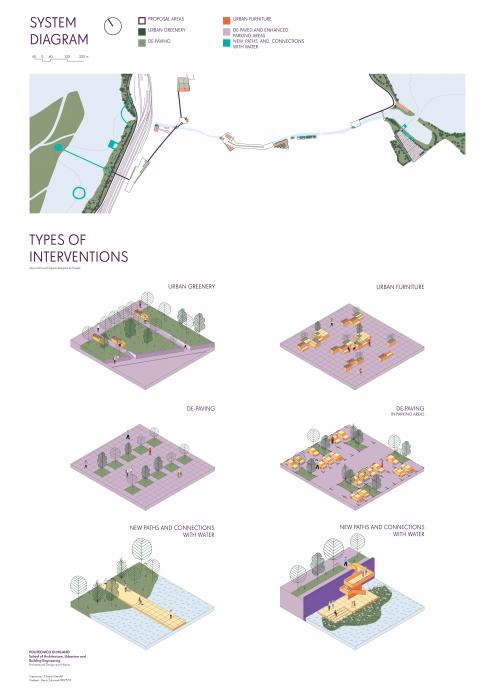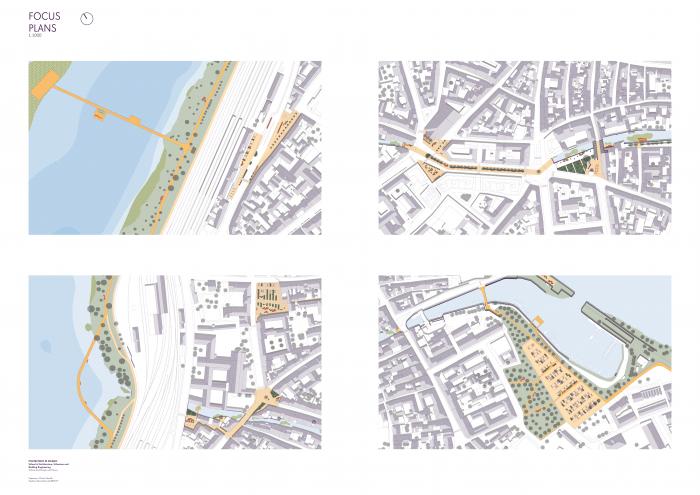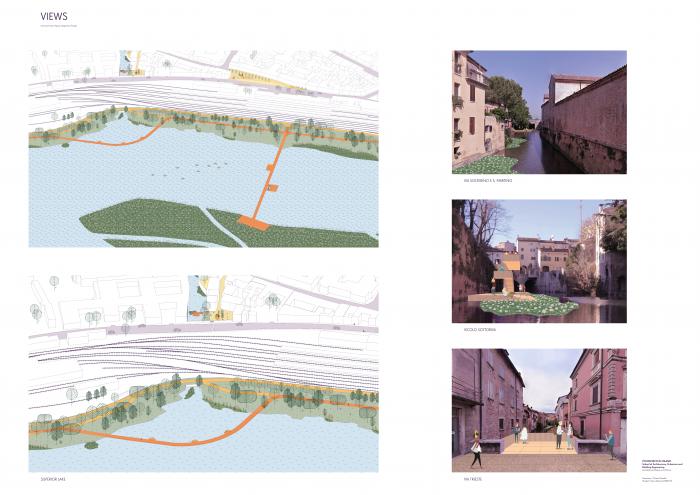Part of the World Heritage Sites of UNESCO, the city of Mantua has always been highly connected to its landscape. Surrounded on the three sides by lakes, its riverbanks are the most important green areas of the city, yet they are not well connected to the center. The project proposes to enhance the existing green system of Mantua and improve its relationship with the water elements, through public spaces and new urban installations that can generate a continuous green ring for the city.
Mantua, which is part of the World Heritage Sites of UNESCO together with Sabbioneta, has always been an important historical city that is highly connected to its landscape. Now surrounded on the three sides by lakes, the city was originally an island settlement, characterised by a long history of control over the water and drainage. Still today, the most important features through which the city represents itself, after its historical heritage, are its lakes and the landscape. The riverbanks of Mantua can be described as one of the most important green spaces of the historical city. In 2018, Mantua was chosen to be the greenest city in Italy. Yet, it is possible to observe that green areas cannot find a place in the historic centre and the existing system of green areas of the riverbanks is not well connected to the city. In order to address these issues, the project proposes to enhance this system and giving a new identity to the riverbanks, focusing especially on the riverbank of the Superior Lake, which is the most undervalued. The project also connects the riverbanks through the existing inner water system of the city, the Rio Canal, thus strengthening the relationship between the city and water. The proposal involves different undervalued public spaces directly related to the riverbanks, classified by the UNESCO as “areas with functions in contrast with the place’s value” and it introduces new urban greenery in the historic city centre. One of the visions of UNESCO, in terms of landscape, is the green ring of the city. Many areas belonging to this ring are still today not actively used by the citizens. The project proposes an additional inner green ring, generated by the Rio Canal, which is enhanced through urban and water installations. The historical city centre can thus be also becoming part of the green structure of the city.
Thesis project by Deniz Eskicirak
Name of the Institute: Politecnico di Milano
Supervisor: Chiara Geroldi
Please highlight how the concept/idea can be exemplary in this context
The proposal focuses on 3 main elements: the riverbanks, the Rio canal and the ‘piazze’. The goal of the project is to generate a system of urban greenery that connects all these elements together. In this context a lot of objectives are considered such as the water quality, pedestrian and cycle mobility, reclaiming car parking areas, urban greenery and redevelopment of undervalued areas.
As a city that is surrounded on the three sides with lakes and with a canal that passes in the middle, Mantua has a distant relationship with its water elements. When we try to understand the reason behind this we find industrialisation, as it led to a massive pollution in the waters. Even though these industrial areas are not working anymore and the polluted areas are inside the National Remediation Program since 2002, restoring the relationship is a long process. While 60 years ago it was possible to swim in these waters, now the general opinion is that they are poisonous. In my proposal I want to break these barriers between the people and the water elements of the city by creating areas that bring them closer such as pontoon bridges and urban balconies. The project also aims to increase the importance of the natural elements in people's lives such as the famous Lotus flowers that are situated mainly on the Superiore Lake.
Another aspect that I address in my proposal is the pedestrian and cycle mobility. One of the first things I noticed about this small city was the amount of cars. Except for a handful of piazze in the city center, all the rest were reserved for car parks. It is very naive to expect all the cars to disappear overnight, but in my proposal I focus on certain piazze that are undervalued and suggest to transform them into urban parks that can also work together with the water elements. In this way more green elements could be implemented inside the city center, as opposite to the current situation where almost all the greenery is pushed to the riverbanks.
Please highlight how the concept/idea can be exemplary in this context
Working in a historical context such as Mantua that is also protected by UNESCO, one of the aims of the proposal is being as reversible as possible. Another objective is to bind this system of urban greenery also in an aesthetic manner. Therefore the project proposes different kind of reversible interventions that can work in unity. We can divide these interventions in 4 different categories: urban greenery, de-paving, urban furniture, and new paths and connections with the water. All these interventions take into consideration the current and historical state of the area. They aim to create different types of focal points that draws people in.
The first type of intervention, urban greenery, working together with the peri-urban park of the lakes, aims to offer a ‘green garden’ inside the urban context. De-paving is the suggestion of green elements in several areas of the system. This intervention is especially proposed for the parking spaces as a way of involving in the green system with the addition of green areas inside. The proposed urban furniture is formed by basic geometric volumes and accommodates urban greenery in different parts of the city with different combinations. In order to strengthen the presence of the Rio Canal for the citizens, urban balconies or platforms on the water are proposed in the strategic points that can work together with the squares and green areas. For the case of the Superior Lake, with the implementation of pontoon bridges on the water, a new connection with the famous lotus flowers of Mantua is aimed to be achieved.
Please highlight how the concept/idea can be exemplary in this context
The essence of the proposal is about accessibility, public participation and affordability. At the research stage of this project, certain undervalued areas caught my attention, such as the riverbanks of the Superiore Lake, some historical squares that are covered with cars and the limited relations with the Rio canal. When I went deeper I also saw that some of these areas are more detached from the city life because of barriers or lack of accessibility. Taking inspiration from different types of projects that were already done in Mantua and the other parts in the world, in my proposal, I try to show a scenario that can transform these undervalued areas with some simple interventions. It is possible to turn inaccessible into accessible. In this hypothetical scenario, the expected result is a higher public use in these areas.
In my project, I focus on several areas in the city that can work together as a system. But as a consequence these areas also have their individual values. So the project does not mandate to be built all at the same time. It gives the flexibility to be completed over time. Another point is that the interventions that are proposed are simple and reversible. The purpose of the project is the show a simple way of transforming these public areas that is also economical.
Please highlight how this approach can be exemplary
One thing that ties all these three dimensions is simplicity. The project aspires to generate new connections and new types of public spaces for the city. Starting from the existing problems and needs of the current situation, the objective was the find simple and comprehensive solutions that can be applied to different areas to establish a sense of unity and aesthetic language. In every step of the project the most important question was the comfort and use of the public. Taking consideration of the high car density in the city, the proposal tries to search for different solutions for pedestrians, cyclers and cars where they can all benefit from the public spaces. It aims to be sustainable, reversible and flexible so that the project can also evolve as the community is evolving.
Being in a historical context such as Mantua, the starting point of the project was the past. Looking at all the available data, photos and analysis to understand how the city was before, the first step was a comparison to find the differences between today and the past. In this first approach I started to see many values that are lost over time. The second step was to look at the future. Talking with people from the municipality, reading the news and even following social media, I started to have a complete vision about the future direction of the city. Looking at the future projects, I saw that many of them aim to improve the connection between the city and the water elements and improve the existing green areas. One missing concept, though, is a system that binds these public areas to each other. As a result, the project’s approach is about establishing a chain of public areas by bringing water, urban greenery and the squares of Mantua together. While creating this chain, the proposal tries to look at the city as a whole but at the same time, it aims to find specific solutions to the individual parts of the chain.
In the project, I focus on a system that is built around the water elements, urban greenery and the squares of Mantua. But on a bigger scale there are many other areas in the city that these interventions can expand into. The masterplan looks at the city center as a whole but in my proposal I chose to focus on a portion of it, possibly the most complicated part that consists of all the main elements to go deeper on the types of interventions and how each area can be transformed.
Looking at the map of Mantua, we see the limits of the city is quite wide, but for the people living in Mantua, there is a much stronger invisible limit that defines the borders of the city. In this direction, the next step would be to look also on the parts of the city outside this invisible limit and see how those areas can be also part of the system; to go deeper on the lakes as a limit for the city and search for solutions that can bring the two sides of the lake closer to each other and generate a deeper connection through the water.
If my project is awarded in the New European Bauhaus Prizes 2022, I would like to use the award money as an investment on myself. My ultimate goal is to have my own studio in the future. So this award would let me take the first steps towards accomplishing my dream. At the moment, unfortunately, it is not possible because I don’t have the resources or the time. In the possibility that my project is awarded, I would take some time off from my job, not immediately but possibly in a year or two, and use the award to build my own identity inside the architectural world. Although in a realistic perspective this award could seem little compared to what I want to accomplish, I think it would be a good start and a pushing force to reach my goal sooner.
@ESKICIRAK, 2022
Content licensed to the European Union.
